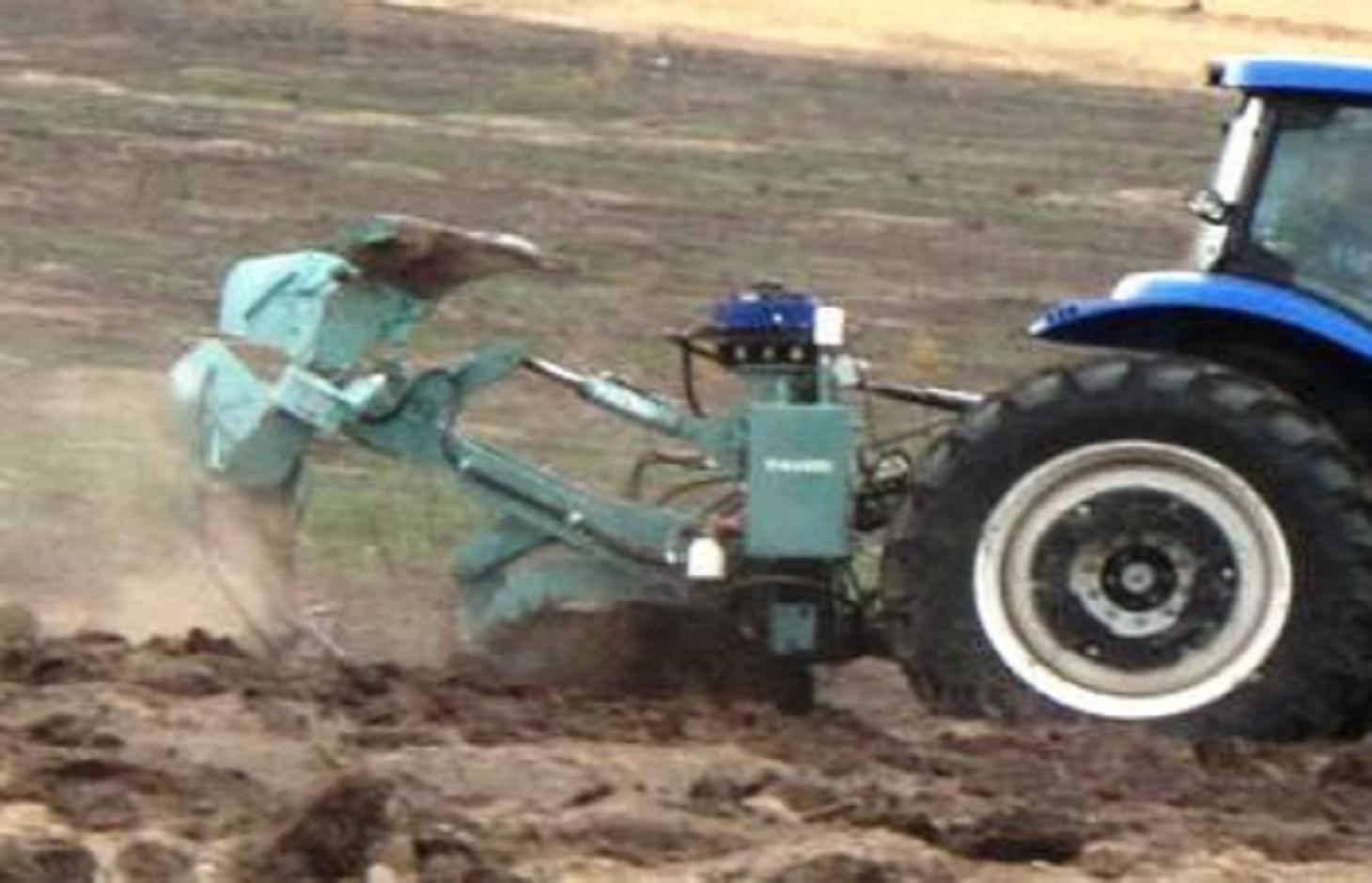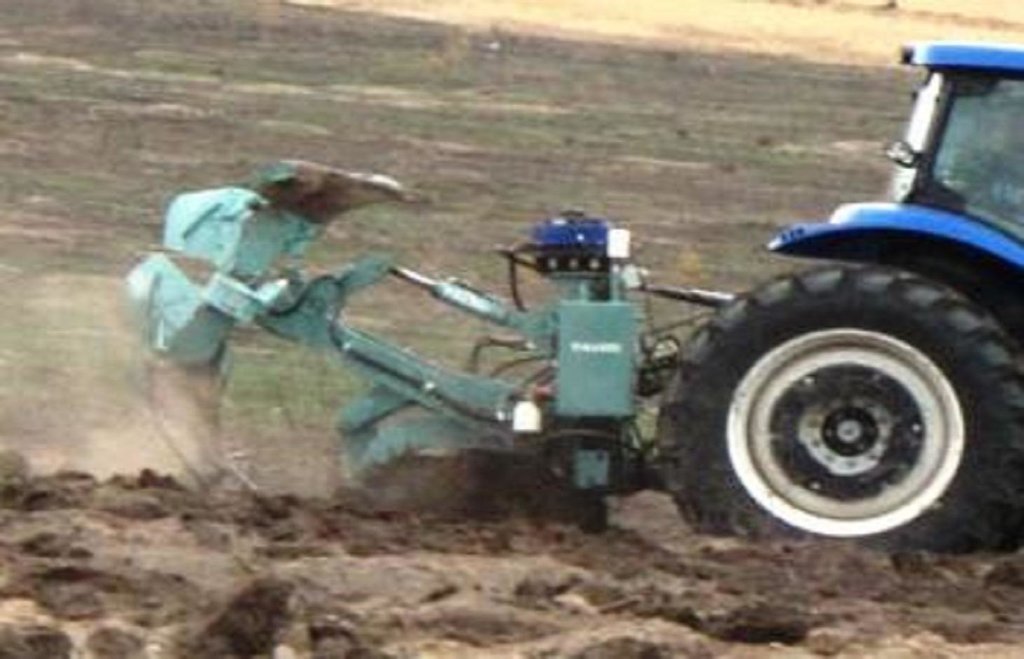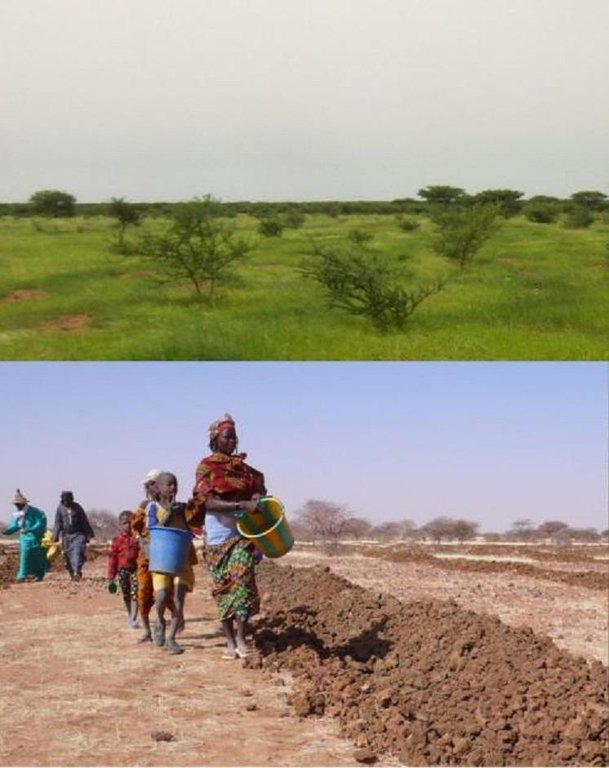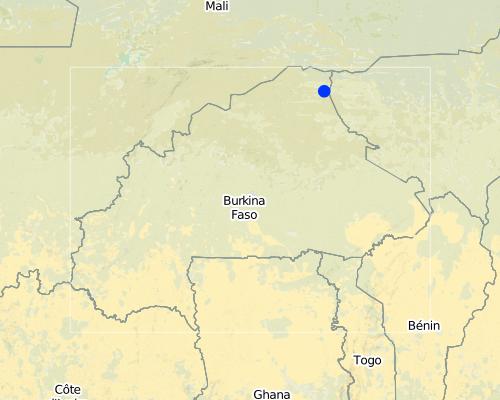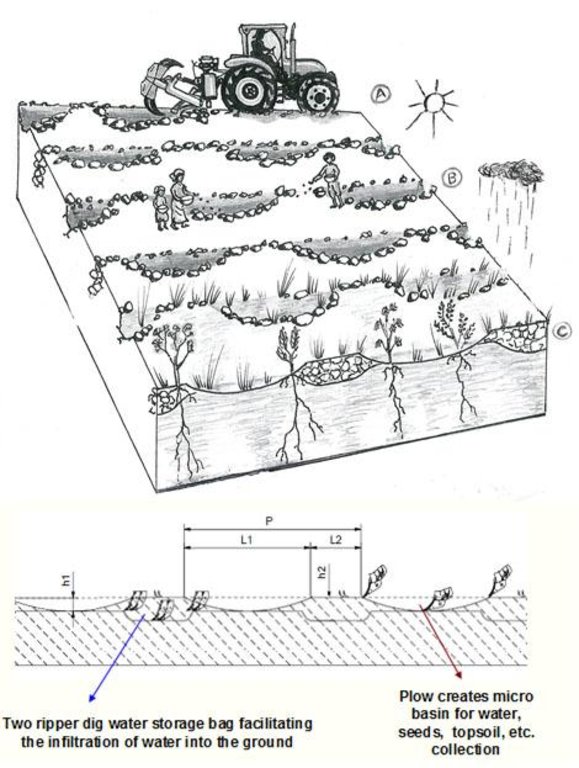Vallerani system [Burkina Faso]
- Creation:
- Update:
- Compiler: Sabina Galli Vallerani
- Editor: –
- Reviewer: Deborah Niggli
technologies_1528 - Burkina Faso
- Full summary as PDF
- Full summary as PDF for print
- Full summary in the browser
- Full summary (unformatted)
- Vallerani System: July 16, 2018 (inactive)
- Vallerani System: July 16, 2018 (inactive)
- Vallerani System: July 12, 2018 (inactive)
- Vallerani System: Aug. 15, 2018 (inactive)
- Vallerani system: April 4, 2018 (inactive)
- Vallerani system: Jan. 4, 2017 (inactive)
- Vallerani System: Sept. 30, 2020 (public)
- Vallerani System: March 8, 2019 (inactive)
View sections
Expand all Collapse all1. General information
1.2 Contact details of resource persons and institutions involved in the assessment and documentation of the Technology
1.3 Conditions regarding the use of data documented through WOCAT
When were the data compiled (in the field)?
03/05/2012
The compiler and key resource person(s) accept the conditions regarding the use of data documented through WOCAT:
Yes
1.4 Declaration on sustainability of the described Technology
Is the Technology described here problematic with regard to land degradation, so that it cannot be declared a sustainable land management technology?
No
2. Description of the SLM Technology
2.1 Short description of the Technology
Definition of the Technology:
A special tractor-pulled plough that automatically constructs water-harvesting catchments, ideally suited for large-scale reclamation work.
2.2 Detailed description of the Technology
Description:
The Vallerani implement is a modified plow named Delfino3, pulled by a heavy-duty tractor. A normal plow on flat land excavates a symmetrical furrow, and earth piles up equally on both sides of the furrow. The Delfino3 plow has a single reversible plowshare that creates an angled furrow and piles up the excavated soil only on the lower (downhill) side. This soil forms a ridge that stops or slows down runoff water as it flows downhill. The plow’s blade moves up and down (i.e. in and out of the soil), creating micro basins about 5 meters long, 50 cm deep and spaced about 2 m, each with a ridge. Two ripper placed before the plow work the soil to a depth of 70 cm, rise at the basin and descend between the basins. Thus to attain, in the stretch of land between the crescent, a collection bag which receives water from the crescents itself. Even with very low rainfall (150-500 mm/year) each micro-basin/storage bag can collect 1500 litres of water, including runoff. This water is protected against evaporation and remains available to plant roots and groundwater.
The Vallerani System is based on direct sowing of seeds of shrubs and trees of locally available, indigenous species. They are sown along the ridges of the basins and in the wake of the ripper. In the case study area Acacia tortilis, Ziziphus mauritania, Balanites aegyptiaca, Acacia senegal, Acacia seyal and Faidherbia albida have been sown. While for most species seeds can be collected by the local population, for species rarely present in the region, the seeds have to be purchased from tree nurseries. The use of goat excrements containing seeds has also proven successful (about 95% of all micro basin have at least one tree growing after 3 years) when directly sown. With more moisture available for a long time trees grow rapidly and the herbaceous cover improves in quality and in quantity - providing 20-30 times more livestock fodder (1000-2000kg dry herbaceous biomass ha/year), also helping to conserve the soil. The plowed and sown area is not protected by fences, grazing of animals shall be allowed so that villagers can benefit from the forage and reduce the accumulation of biomass fuel that would further the risk of fires in the dry season.
The Vallerani plow can ‘treat’ up to 20 ha, digging 5.720 micro basins, in a single day. The speed and effectiveness of the Delfino3 plow are its major advantages in the fight against desertification, but can also be its major limitation as to be able to make the best of it, it is necessary to find great availability of land to be reforested or cultivate. This is mainly possible related to a large public or business initiative. The spreading "like wildfire" that has characterized the case study was made possible by the presence on the territory of an NGO already active and rooted in the territory for many years and by perseverance, respect and competence of partner "of the North". Once the project has invested in the tractor and the plow (tractor ~ 70,000 EUR, plough ~ 40,000 EUR), the remaining cost of implementation – labour costs for local workers and drivers, fuel etc. amount to around EUR 125 / ha / year.
The case study area in the north east of Burkina Faso receives about 300-500 mm of annual rainfall. The soils of this agropastoral land are heavily degraded with a low tree density and an almost entirely absent herbaceous cover.
2.3 Photos of the Technology
2.5 Country/ region/ locations where the Technology has been applied and which are covered by this assessment
Country:
Burkina Faso
Region/ State/ Province:
Oudalan
Further specification of location:
Gorom-Gorom
Map
×2.6 Date of implementation
If precise year is not known, indicate approximate date:
- 10-50 years ago
2.7 Introduction of the Technology
Specify how the Technology was introduced:
- during experiments/ research
3. Classification of the SLM Technology
3.1 Main purpose(s) of the Technology
- improve production
- reduce, prevent, restore land degradation
3.2 Current land use type(s) where the Technology is applied

Grazing land
Extensive grazing land:
- Semi-nomadism/ pastoralism

Mixed (crops/ grazing/ trees), incl. agroforestry
Comments:
Major land use problems (compiler’s opinion): Land degradation-desertification with reduction of vegetation cover in terms of plant density and species diversity is the main problem: disappearance of grasses and trees, reduction of the size of the plants that are resistant and of the biological activity of the soil. Runoff, water and wind erosion increase. Drought and irregular precipitation have heavy consequences on soil fertility, availability of water for humans and livestock, and recharging groundwater.
3.3 Further information about land use
Water supply for the land on which the Technology is applied:
- rainfed
Number of growing seasons per year:
- 1
Specify:
Longest growing period in days: 90
3.4 SLM group to which the Technology belongs
- water harvesting
3.5 Spread of the Technology
Comments:
Total area covered by the SLM Technology is 50 m2.
3.6 SLM measures comprising the Technology

vegetative measures
- V1: Tree and shrub cover
- V2: Grasses and perennial herbaceous plants

structural measures
- S4: Level ditches, pits

management measures
- M2: Change of management/ intensity level
3.7 Main types of land degradation addressed by the Technology

soil erosion by water
- Wt: loss of topsoil/ surface erosion
- Wg: gully erosion/ gullying

soil erosion by wind
- Et: loss of topsoil

chemical soil deterioration
- Cn: fertility decline and reduced organic matter content (not caused by erosion)

physical soil deterioration
- Pc: compaction

biological degradation
- Bc: reduction of vegetation cover
- Bh: loss of habitats
- Bs: quality and species composition/ diversity decline
Comments:
Main causes of degradation: over-exploitation of vegetation for domestic use, overgrazing, change of seasonal rainfall, droughts
Secondary causes of degradation: deforestation / removal of natural vegetation (incl. forest fires), education, access to knowledge and support services
3.8 Prevention, reduction, or restoration of land degradation
Specify the goal of the Technology with regard to land degradation:
- restore/ rehabilitate severely degraded land
4. Technical specifications, implementation activities, inputs, and costs
4.1 Technical drawing of the Technology
4.2 Technical specifications/ explanations of technical drawing
Above:
A. The land chosen together with the local population is plowed with the special Delfino3 plow. B. Local people sow seeds (collected from local trees or bought if species are rare) or goat dung containing seeds (collected in the night enclosures after feeding the goats shaking trees with ripe seeds). C. The micro basins collect the rain that falls into the crescents and 50% of the runoff water. The water easily penetrates into the soil, fills the storage bags, remains available to plant roots and drains into the groundwater without risk of evaporation. Each micro basin/storage bag can collect up to 1.500 l of water.
Below
h1-Depth of the ploughshares work: =40/50 cm
Width of the micro basin: 40/50 cm
L1-Length of the micro basin, programmable: =3,5/5 m
h2 Depth of the rippers work: =50/80 cm
P-Total length of work: 4/8 m
Tractors horsepower 210/250 (150-198 Kw)
Working speed: 4/7 Km/h
Weight : 2000 Kg
Location: Oudalan, Gorom Gorom province. Burkina Faso
Technical knowledge required for field staff / advisors: high
Main technical functions: control of raindrop splash, improvement of ground cover, improvement of topsoil structure (compaction), stabilisation of soil (eg by tree roots against land slides), water harvesting / increase water supply, increase of biomass (quantity), promotion of vegetation species and varieties (quality, eg palatable fodder)
Secondary technical functions: increase in organic matter, increase in nutrient availability (supply, recycling,…), increase of infiltration, increase / maintain water stored in soil
Retention/infiltration ditch/pit, sediment/sand trap
Spacing between structures (m): 0.5
Depth of ditches/pits/dams (m): 2
Length of ditches/pits/dams (m): 5
Change of land use practices / intensity level
4.4 Establishment activities
| Activity | Type of measure | Timing | |
|---|---|---|---|
| 1. | Project planning, consulting and training by VS and national experts | Structural | |
| 2. | Plowing with the Delfino special plow pulled by a 210hp tractor | Structural | Dry season |
| 3. | Seed harvesting can be done by local people either collecting them directly from plants or by shaking the plants at the appropriate time, to feed the goats and sheep with the fallen seeds and collect their dung in the night enclosure | Structural | |
| 4. | Missing seeds can be purchased in local markets or, if trees are too rare or if the species is no longer present, seeds must be purchased at a nursery | Structural | When seeds are ripe |
| 5. | Direct sowing | Structural | Dry season |
4.5 Costs and inputs needed for establishment
| Specify input | Unit | Quantity | Costs per Unit | Total costs per input | % of costs borne by land users | |
|---|---|---|---|---|---|---|
| Labour | labour | ha | 1.0 | 72.0 | 72.0 | 50.0 |
| Equipment | machine use | ha | 1.0 | 23.4 | 23.4 | |
| Total costs for establishment of the Technology | 95.4 | |||||
4.6 Maintenance/ recurrent activities
| Activity | Type of measure | Timing/ frequency | |
|---|---|---|---|
| 1. | No maintenance activities are required | Structural |
4.7 Costs and inputs needed for maintenance/ recurrent activities (per year)
Comments:
All data presented in the table refer to an ideal project which lasts 5 years with 3000 hectares plowed each year. All works are carried for economic retribution. Item number 1 refers to the planning, training and consulting engineers that has a strong impact on the cost per ha ($47). This voice would remain the same if 3 MTU (Mechanized Technical Unit) were used in the same area reducing its impact to $ 15,6 per ha.
4.8 Most important factors affecting the costs
Describe the most determinate factors affecting the costs:
Upfront costs for the aquisition of the required materials are around 40,000 EUR for the plough and 70,000 EUR for the tractor.
5. Natural and human environment
5.1 Climate
Annual rainfall
- < 250 mm
- 251-500 mm
- 501-750 mm
- 751-1,000 mm
- 1,001-1,500 mm
- 1,501-2,000 mm
- 2,001-3,000 mm
- 3,001-4,000 mm
- > 4,000 mm
Specifications/ comments on rainfall:
400-600 mm
Agro-climatic zone
- arid
Thermal climate class: subtropics
5.2 Topography
Slopes on average:
- flat (0-2%)
- gentle (3-5%)
- moderate (6-10%)
- rolling (11-15%)
- hilly (16-30%)
- steep (31-60%)
- very steep (>60%)
Landforms:
- plateau/plains
- ridges
- mountain slopes
- hill slopes
- footslopes
- valley floors
Altitudinal zone:
- 0-100 m a.s.l.
- 101-500 m a.s.l.
- 501-1,000 m a.s.l.
- 1,001-1,500 m a.s.l.
- 1,501-2,000 m a.s.l.
- 2,001-2,500 m a.s.l.
- 2,501-3,000 m a.s.l.
- 3,001-4,000 m a.s.l.
- > 4,000 m a.s.l.
5.3 Soils
Soil depth on average:
- very shallow (0-20 cm)
- shallow (21-50 cm)
- moderately deep (51-80 cm)
- deep (81-120 cm)
- very deep (> 120 cm)
Soil texture (topsoil):
- coarse/ light (sandy)
Topsoil organic matter:
- low (<1%)
5.4 Water availability and quality
Ground water table:
> 50 m
Availability of surface water:
good
Water quality (untreated):
for agricultural use only (irrigation)
5.5 Biodiversity
Species diversity:
- low
5.6 Characteristics of land users applying the Technology
Off-farm income:
- less than 10% of all income
Individuals or groups:
- groups/ community
Gender:
- women
- men
Indicate other relevant characteristics of the land users:
Land users applying the Technology are mainly common / average land users
Difference in the involvement of women and men: The project involves the reforestation and reconstruction of the herbaceous layer for the grazing of livestock that are male dominated activities. Since 2010 women have sown special plants for medical use, domestic use and as raw material for crafts and protected them from grazing.
Population density: 10-50 persons/km2
Annual population growth: 3% - 4%
Off-farm income specification: The only activity people of the region are engaged in is goat and cattle breading. Crop production is practiced only for subsistence use.
5.7 Average area of land owned or leased by land users applying the Technology
- < 0.5 ha
- 0.5-1 ha
- 1-2 ha
- 2-5 ha
- 5-15 ha
- 15-50 ha
- 50-100 ha
- 100-500 ha
- 500-1,000 ha
- 1,000-10,000 ha
- > 10,000 ha
Is this considered small-, medium- or large-scale (referring to local context)?
- small-scale
5.8 Land ownership, land use rights, and water use rights
Land ownership:
- state
- communal/ village
Land use rights:
- open access (unorganized)
- communal (organized)
Water use rights:
- open access (unorganized)
- communal (organized)
5.9 Access to services and infrastructure
health:
- poor
- moderate
- good
education:
- poor
- moderate
- good
technical assistance:
- poor
- moderate
- good
employment (e.g. off-farm):
- poor
- moderate
- good
markets:
- poor
- moderate
- good
energy:
- poor
- moderate
- good
roads and transport:
- poor
- moderate
- good
drinking water and sanitation:
- poor
- moderate
- good
financial services:
- poor
- moderate
- good
6. Impacts and concluding statements
6.1 On-site impacts the Technology has shown
Socio-economic impacts
Production
fodder production
Comments/ specify:
up to 30% more than before implementation
fodder quality
wood production
Quantity before SLM:
50 trees/ha
Quantity after SLM:
350 trees/ha
Socio-cultural impacts
food security/ self-sufficiency
Comments/ specify:
The technology can be applied for agriculture producing 2 to 4 times more than with traditional systems
health situation
Comments/ specify:
No more malnutrition=better health!
cultural opportunities
recreational opportunities
Comments/ specify:
More wood, fodder and water available= more time available
community institutions
Comments/ specify:
Old, young and woman work together for common benefits
national institutions
Comments/ specify:
Were applied on large scale
SLM/ land degradation knowledge
Comments/ specify:
Environment education in theory and practice, is part of the system
conflict mitigation
Comments/ specify:
More fodder and water highly reduces conflict motivations
situation of socially and economically disadvantaged groups
Comments/ specify:
Women have collected, sown and protected medicinal plants and plants for raw materials for handcrafts to sell at the market
Training of skilled labour in disadvantaged regions
Comments/ specify:
Chance to find good jobs
contribution to human well-being
Comments/ specify:
Thanks to the enormous increase of trees, pasture and crop production, the quality of life and health of men and animals have improved considerably.
Ecological impacts
Water cycle/ runoff
harvesting/ collection of water
surface runoff
groundwater table/ aquifer
Soil
soil moisture
soil loss
soil compaction
nutrient cycling/ recharge
soil organic matter/ below ground C
Biodiversity: vegetation, animals
biomass/ above ground C
Climate and disaster risk reduction
fire risk
Comments/ specify:
Through the high soil cover with trees and grass fire risk increase, this is avoided through open access to grazing.
Other ecological impacts
Increased threat from wild animals
Comments/ specify:
Biodiversity highly increases, local people might be afraid of some animals coming back like jackal or snakes
6.2 Off-site impacts the Technology has shown
downstream flooding
damage on public/ private infrastructure
6.3 Exposure and sensitivity of the Technology to gradual climate change and climate-related extremes/ disasters (as perceived by land users)
Gradual climate change
Gradual climate change
| Season | Type of climatic change/ extreme | How does the Technology cope with it? | |
|---|---|---|---|
| annual temperature | increase | well |
Climate-related extremes (disasters)
Meteorological disasters
| How does the Technology cope with it? | |
|---|---|
| local rainstorm | well |
| local windstorm | well |
Climatological disasters
| How does the Technology cope with it? | |
|---|---|
| drought | well |
Hydrological disasters
| How does the Technology cope with it? | |
|---|---|
| general (river) flood | not known |
Other climate-related consequences
Other climate-related consequences
| How does the Technology cope with it? | |
|---|---|
| reduced growing period | well |
6.4 Cost-benefit analysis
How do the benefits compare with the establishment costs (from land users’ perspective)?
Short-term returns:
very negative
Long-term returns:
very positive
How do the benefits compare with the maintenance/ recurrent costs (from land users' perspective)?
Short-term returns:
negative
Long-term returns:
very positive
6.5 Adoption of the Technology
- more than 50%
Of all those who have adopted the Technology, how many have did so spontaneously, i.e. without receiving any material incentives/ payments?
- 0-10%
Comments:
100% of land user families have adopted the Technology with external material support
Comments on acceptance with external material support: The system includes the use of a heavy duty tractor and a special plow whose costs are high though difficult to sustain by the local population. All correlated activities are done (or can be done) without external material support
There is a strong trend towards spontaneous adoption of the Technology
The system includes the use of a heavy duty tractor and a special plow whose cost is high though difficult to sustain by the local population. All other activities part of the system are practicable from the population under an initial guidance of someone with specific training. Where the technology is known there is active participation of local people and a strong demand for new interventions
6.7 Strengths/ advantages/ opportunities of the Technology
| Strengths/ advantages/ opportunities in the compiler’s or other key resource person’s view |
|---|
| This practice allows for the rapid and efficient treatment of large degraded areas within a short time |
| The tree and shrub species planted are mainly indigenous and locally adapted species |
| Through its tillage process the Vallerani system offers the highest degree of efficiency in the first years from processing. Its effects last for a long time so it does not need to be repeated on the same site |
| The VS does not use any water (except rain) in countries where water is rare and precious. It further avoids the risk of soil salinisation. |
| The delfino3 can plow strongly degraded land, this makes that local people often ask to work their worse land |
6.8 Weaknesses/ disadvantages/ risks of the Technology and ways of overcoming them
| Weaknesses/ disadvantages/ risks in the compiler’s or other key resource person’s view | How can they be overcome? |
|---|---|
| The investment costs for the machinery are extremely high and cannot be covered by single land users or even communities | projects must be financed externally |
| The speed and effectiveness of the Delfino3 plow are its major advantages in the fight against desertification, but can also be its major limitation as to be able to make the best of it, it is necessary to find great availability of land to be reforested or cultivate | This is mainly possible related to a large public or business initiative. The spreading "like wildfire" that has characterized the case study was made possible by the presence on the territory of an NGO already active and rooted in the territory for many years and by perseverance, respect and competence of the partner "of the North" |
| Since great extentions will be processed, a big organisation is needed for all activities (awareness raising, collecting seeds, personnel training, logistics, etc), | this must be well organized and should operate already before starting plowing |
7. References and links
7.1 Methods/ sources of information
- field visits, field surveys
- interviews with land users
7.2 References to available publications
Title, author, year, ISBN:
Conedera, M., N. Bomio-Pacciorini, et al. 2010. Reconstitution des écosystèmes dégradés sahéliens. Bois et Forêts des Tropiques 304(2).
Available from where? Costs?
http://www.vallerani.com/images/Reconstitution.pdf
Title, author, year, ISBN:
Akhtar Ali, Theib Oweis, Atef Abdul Aal, Mohamed Mudabbar, Khaled Zubaidi, and Adriana Bruggeman. 2006. The Vallerani Water Harvesting System. ICARDA Caravan No. 23.
Available from where? Costs?
http://www.vallerani.com/images/Caravan-23.pdf
Links and modules
Expand all Collapse allLinks
No links
Modules
No modules


